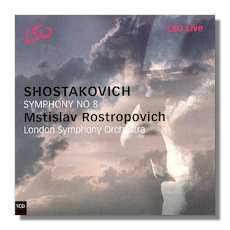
The Internet's Premier Classical Music Source
Related Links
- Shostakovich Reviews
- Latest Reviews
- More Reviews
-
By Composer
-
Collections
DVD & Blu-ray
Books
Concert Reviews
Articles/Interviews
Software
Audio
Search Amazon
Recommended Links
Site News
 CD Review
CD Review
Dmitri Shostakovich

Symphony #8 in C minor, Op. 65 (1943)
London Symphony Orchestra/Mstislav Rostropovich
LSO Live LSO0060 68:45
Also available on Hybrid Multichannel SACD LSO0527:
Amazon
- UK
- Germany
- Canada
- France
- Japan
- ArkivMusic
- CD Universe
- JPC
Summary for the Busy Executive: Despair.
Shostakovich had already come off the tremendous success of his Seventh Symphony, the "Leningrad", which achieved the status of World War II musical icon (along with Beethoven's Fifth), when he presented the Eighth. The "Leningrad" had been conceived as a rallying cry, an encouragement to Russians to resist the Nazi invasion. By 1943, the Soviets had broken the back of the German army at both Leningrad and Stalingrad. People saw clearly that, at least on the Eastern Front, the Germans were finished, and they (the Soviet hierarchy in particular) expected a hymn to victory. Shostakovich gave them instead a work which mourned the losses and the suffering. If the Seventh was highly successful poster art, the Eighth mined a more personal vein. The government resented it and singled it out in the Zhdanov condemnation of 1948, which blasted "formalist" tendencies in the best (and the middling) Soviet composers. Prokofieff and Khachaturian also received warnings. Dismissed from teaching posts and with his music purged from concert programs, Shostakovich did his usual thing to survive. He heaped ashes and coals on his own head, wrote some dreck to Party commissions as well as scores to forgettable films, and continued to write for himself. The harrowing Piano Trio #2 and the Piano Sonata #2 also come from around the time of the Eighth, and the First Violin Concerto follows.
Unlike many, I don't dump on the Seventh. Even Bartók's send-up in the Concerto for Orchestra, although beautiful, strikes me as missing the satirical point. We would do well to remember that the Russian symphonic tradition is largely a programmatic one, doubly so under the Soviets. Composers as diverse as Tchaikovsky, Rimsky-Korsakov, Balakirev, Borodin, Rachmaninoff, Prokofieff, and Shostakovich largely saw their composing missions to express the state of their souls or the state of the times or a reading of history. Shostakovich's Seventh is a newspaper of a symphony. The Eighth is more like a diary or a poem.
It contains five movements: "Adagio – Allegro non troppo," two scherzi, back-to-back, a slow movement, and an "Allegretto" finale. The first movement, almost twice as long as any of the others and as long as a Classical symphony, begins with an arresting call on the low strings – a kind of update to the Baroque French overture. Here, however, the goal of the introduction is not glory, but epic speech. It leads to a hushed, folk-like lament, dominated by strings. Gradually, the music gels, first into a slow march. Then, as its rhythmic spine stiffens, brass takes over, and the symphony becomes brutal, horrifying. Eventually, it crashes into quiet, with the return of the opening music, even more subdued. Shostakovich deceptively marks the next movement "Allegretto." Instead of the light ramble we expect, he gives us a heavily-mechanized march, with a trio for sarcastic imps. An angry moto perpetuo follows, punctuated (and that's the word) by stamps, screams, and alarums. After a grotesque "military" polka trio, the moto perpetuo returns and builds to a savage climax, which breaks into the slow movement, a tragic, subdued passacaglia, a form beloved by Shostakovich and which brought forth some of his most intense music. Here, the music could accompany "the field of the dead." It gets the revulsion at the horror and the numbness that this provokes, while also mourning deeply.
Shostakovich might have gotten away without censure with the first four movements, had only he provided an optimistic, rah-rah ending. In his public statements, he rather disingenuously proposed that the ending was indeed optimistic, pointing out parallels to folk music, almost always a winner in Soviet Russia. Indeed, it does begin that way, with cheerful chirps from the flute against pizzicato accompaniment. It didn't work. Even at the time, six years before Zhdanov, audiences remarked on its "pessimism." Indeed outright joy is rather curiously under wraps, and a melancholy undercurrent continually lies close at hand. Eventually, it angrily breaks through, resulting in a violent climax. The "merry" music returns, but in context it comes across as a grotesque danse macabre, like one of Mahler's more outrageous Ländlers. A gentle passage, mainly in the strings, follows – a foretaste of similar music in the finale to the Symphony #13. It reminds me a bit of the last act of Lear, and just before the "happily ever after" possibility is dashed by Cordelia's death. The symphony ends softly, but not peacefully.
Rostropovich, although certainly capable, never particularly impressed me as a conductor before, but this account stunned me. Not only did the tightness of the live performance make my jaw drop, but Rostropovich fully understands the score's emotional climate and reveals the considerable stature of the work. Furthermore, the sonics are superb. Undoubtedly a top choice for this symphony.
Copyright © 2011, Steve Schwartz.





















